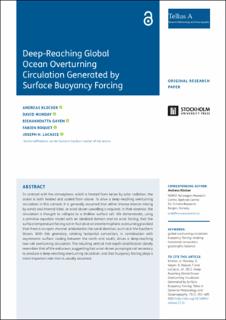| dc.contributor.author | Klocker, Andreas | |
| dc.contributor.author | Munday, David | |
| dc.contributor.author | Gayen, Bishakhdatta | |
| dc.contributor.author | Roquet, Fabien | |
| dc.contributor.author | Lacasce, Joseph Henry | |
| dc.date.accessioned | 2024-02-15T12:01:56Z | |
| dc.date.available | 2024-02-15T12:01:56Z | |
| dc.date.created | 2024-01-02T15:09:53Z | |
| dc.date.issued | 2023 | |
| dc.identifier.citation | Tellus A: Dynamic Meteorology and Oceanography. 2023, 75 (1), 392-409. | en_US |
| dc.identifier.issn | 0280-6495 | |
| dc.identifier.uri | https://hdl.handle.net/11250/3117971 | |
| dc.description.abstract | In contrast with the atmosphere, which is heated from below by solar radiation, the ocean is both heated and cooled from above. To drive a deep-reaching overturning circulation in this context, it is generally assumed that either intense interior mixing by winds and internal tides, or wind-driven upwelling is required; in their absence, the circulation is thought to collapse to a shallow surface cell. We demonstrate, using a primitive equation model with an idealized domain and no wind forcing, that the surface temperature forcing can in fact drive an interhemispheric overturning provided that there is an open channel unblocked in the zonal direction, such as in the Southern Ocean. With this geometry, rotating horizontal convection, in combination with asymmetric surface cooling between the north and south, drives a deep-reaching two-cell overturning circulation. The resulting vertical mid-depth stratification closely resembles that of the real ocean, suggesting that wind-driven pumping is not necessary to produce a deep-reaching overturning circulation, and that buoyancy forcing plays a more important role than is usually assumed. | en_US |
| dc.language.iso | eng | en_US |
| dc.rights | Navngivelse 4.0 Internasjonal | * |
| dc.rights.uri | http://creativecommons.org/licenses/by/4.0/deed.no | * |
| dc.subject | Horisontell konveksjon | en_US |
| dc.subject | Horizontal convection | en_US |
| dc.title | Deep-Reaching Global Ocean Overturning Circulation Generated by Surface Buoyancy Forcing | en_US |
| dc.title.alternative | Deep-Reaching Global Ocean Overturning Circulation Generated by Surface Buoyancy Forcing | en_US |
| dc.type | Peer reviewed | en_US |
| dc.type | Journal article | en_US |
| dc.rights.holder | © 2023 The Author(s) | en_US |
| dc.description.version | publishedVersion | en_US |
| cristin.ispublished | true | |
| cristin.fulltext | original | |
| cristin.qualitycode | 1 | |
| dc.identifier.doi | 10.16993/tellusa.3231 | |
| dc.identifier.cristin | 2219172 | |
| dc.source.journal | Tellus A: Dynamic Meteorology and Oceanography | en_US |
| dc.source.volume | 75 | en_US |
| dc.source.issue | 1 | en_US |
| dc.source.pagenumber | 392-409 | en_US |
| dc.relation.project | Norges forskningsråd: 302743 | en_US |
| dc.relation.project | Andre: Australian Research Council Future Fellowship FT180100037 | en_US |
| dc.subject.nsi | VDP::Meteorologi: 453 | en_US |
| dc.subject.nsi | VDP::Meteorology: 453 | en_US |

